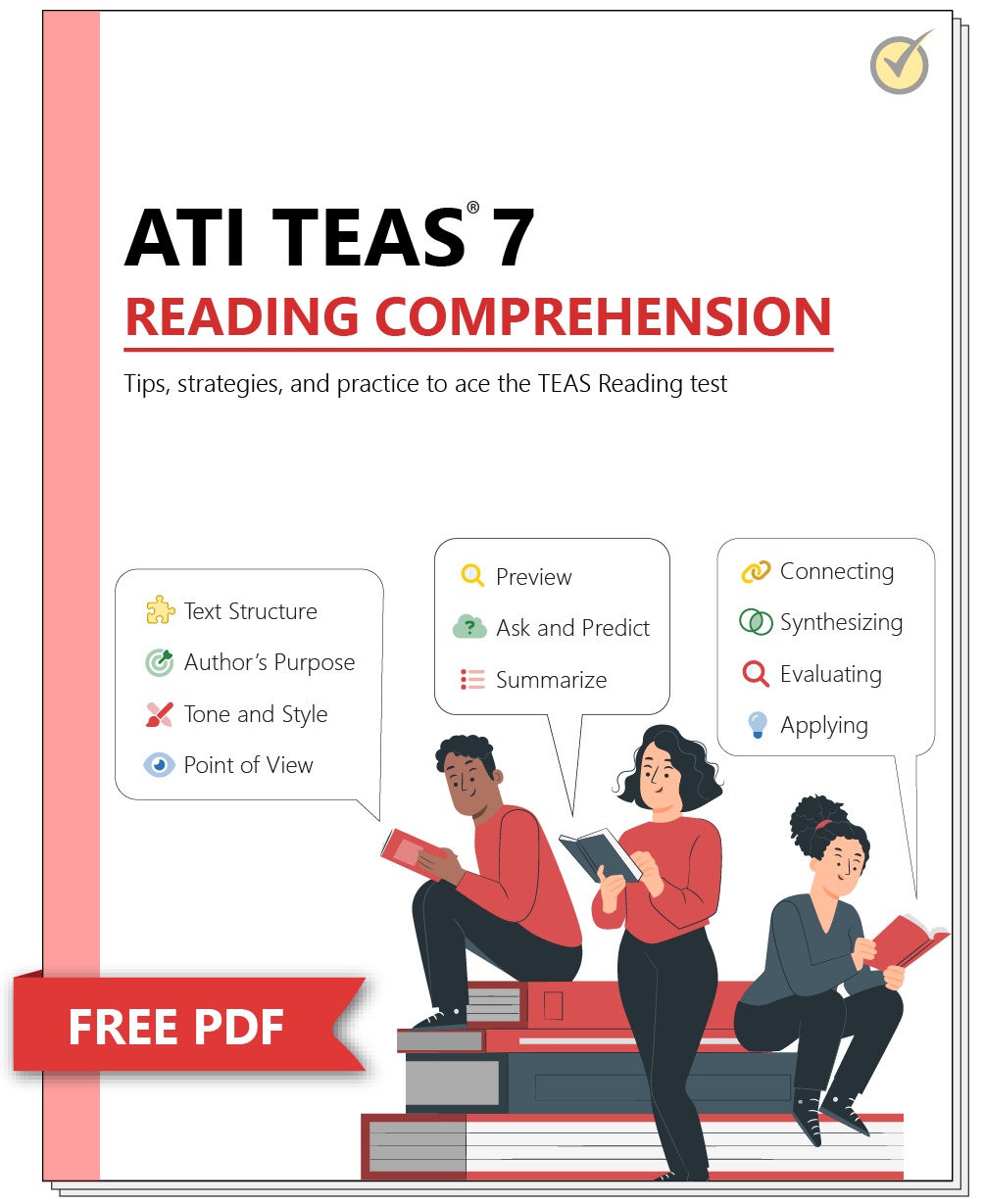The Reading section of the TEAS 7 evaluates specific, complex details of the reading process. To help you prepare for this section of the TEAS, this page contains everything you need to know, including what topics are covered, how many questions there are, and how you can study effectively.
What’s on the TEAS Reading Section?
TEAS Checklist
Top 5 Most Challenging TEAS Reading Questions
Over the last year, we’ve compiled the data from nearly 15,000 test-takers who tried their hand at the practice test at the top of this page. According to the data, around 70%-80% of people answered these five questions incorrectly.
Answer each question and read through the answer explanation, whether you got the answer right or wrong. This will help you ensure you’ve got the topic mastered.
Whether you struggled with these questions or aced them on your first try, be sure to take the full practice test to get a better idea of how prepared you really are!
1. Read the schedule below before answering the question:
 Read Passage
Read Passage
From the information given, on which show would you expect to hear the broadest discussion about national US politics?
2. Read the passage below before answering the question:
 Read Passage
Read Passage- Business Dept: 10:30 a.m.–11:30 a.m.
- Art Dept: 10:45 a.m.–11:45 a.m.
- Math and Science Dept: 12 p.m.–1 p.m.
- Social Sciences Dept: 12:30 p.m.–1:30 p.m.
- Humanities Dept: 1 p.m.–2 p.m.
Based on the information in the announcement, what might the reader assume about how the university determined the lunch schedule?
3. Read the passage below before answering the question:
 Read Passage
Read Passage- Business Dept: 10:30 a.m.–11:30 a.m.
- Art Dept: 10:45 a.m.–11:45 a.m.
- Math and Science Dept: 12 p.m.–1 p.m.
- Social Sciences Dept: 12:30 p.m.–1:30 p.m.
- Humanities Dept: 1 p.m.–2 p.m.
Which best describes the final two sentences of the announcement?
4. Read the passage below before answering the question:
 Read Passage
Read PassageSayers’s first foray into published writing was a collection of poetry released in 1916. Within a few years, she began work on the detective novels and short stories that would make her famous, due to the creation of the foppish, mystery-solving aristocrat Lord Peter Wimsey. Sayers also wrote short story mysteries about the character Montague Egg. In spite of her success as a mystery writer, Sayers continued to balance popular fiction with academic work; her translation of Dante’s Inferno gained her respect for her ability to convey the poetry in English while still remaining true to the Italian terza rima. She also composed a series of twelve plays about the life of Christ, and wrote several essays about education and feminism. In her middle age, Dorothy L. Sayers published several works of Christian apologetics, one of which was so well-received that the archbishop of Canterbury attempted to present her with a doctorate of divinity. Sayers, for reasons known only to her, declined.
Which of the following describes the type of writing used to create the passage?
5. Read the passage below before answering the question:
 Read Passage
Read PassageAwful Event
President Lincoln Shot by an Assassin
The Deed Done at Ford's Theatre Last Night
THE ACT OF A DESPERATE REBEL
The President Still Alive at Last Accounts
No Hopes Entertained of His Recovery
Attempted Assassination of Secretary Seward
DETAILS OF THE DREADFUL TRAGEDY
Official
War Department, Washington April 15, 1:30 A.M. - Maj. Gen. Dis.: This evening at about 9:30 P.M. at Ford's Theatre, the President, while sitting in his private box with Mrs. Lincoln, Mr. Harris, and Major Rathburn, was shot by an assassin, who suddenly entered the box and appeared behind the President. The assassin then leaped upon the stage, brandishing a large dagger or knife, and made his escape in the rear of the theatre.
The pistol ball entered the back of the President's head and penetrated nearly through the head. The wound is mortal. The President has been insensible ever since it was inflicted, and is now dying.
About the same hour an assassin, whether the same or not, entered Mr. Sewards' apartments, and under the pretense of having a prescription, was shown to the Secretary's sick chamber. The assassin immediately rushed to the bed, and inflicted two or three stabs on the throat and two on the face. It is hoped the wounds may not be mortal. My apprehension is that they will prove fatal.
The nurse alarmed Mr. Frederick Seward, who was in an adjoining room, and hastened to the door of his father's room, when he met the assassin, who inflicted upon him one or more dangerous wounds. The recovery of Frederick Seward is doubtful.
It is not probable that the President will live throughout the night.
Gen. Grant and wife were advertised to be at the theatre this evening, but he started to Burlington at 6 o'clock this evening. At a Cabinet meeting at which Gen. Grant was present, the subject of the state of the country and the prospect of a speedy peace was discussed. The President was very cheerful and hopeful, and spoke very kindly of Gen. Lee and others of the Confederacy, and of the establishment of government in Virginia.
All the members of the Cabinet except Mr. Seward are now in attendance upon the President. I have seen Mr. Seward, but he and Frederick were both unconscious.
Edwin M. Stanton, Secretary of War.
Which of the following is NOT evidence of the author’s credibility?
TEAS Online Course
If you want to be fully prepared, Mometrix offers an online TEAS prep course designed to give you everything you need to succeed!
Here’s what you’ll find in the TEAS course:
- 100+ Review Lessons Covering Every Topic
- Over 2,650 TEAS Practice Questions
- 200+ Video Tutorials
- 300+ Digital Flashcards
- Money-back Guarantee
- Mobile Access
Everyone learns differently, so we’ve tailored the TEAS online prep course to ensure every learner has what they need to prepare for the TEAS 7 exam.
Click below to check it out!

TEAS Reading Comprehension Tips
Acing the Reading section on the TEAS requires more than just being able to read.
It’s about how you read.
To help you improve your reading comprehension and boost your confidence to conquer the test, check out this free reading comprehension guide! This PDF is full of tips and tricks, all paired with example reading passages to help you apply what you learn.
FAQs
Q
How many questions are on the TEAS Reading exam?
A
The TEAS reading section is 55 minutes long and contains 45 questions. This section includes six “pretest” questions that do not count toward your final score.
Q
How long is the TEAS Reading exam?
A
The TEAS Reading exam is 55 minutes long, with 45 questions.
Q
What is a passing TEAS Reading score?
A
Institutions decide what score is considered a passing TEAS Reading Score. After taking the exam, you will receive a total score, which includes your scores from all four sections (Reading, Mathematics, Science, and English & Language Usage). You will also receive individual scores for each section. Many programs consider a total score of at least 60% to 70% passing, but students are strongly encouraged to learn more about the score requirements for the nursing program.
TEAS® is a registered trademark of the Assessment Technologies Institute®, which is unaffiliated, not a sponsor, or associated with Mometrix Test Preparation.




